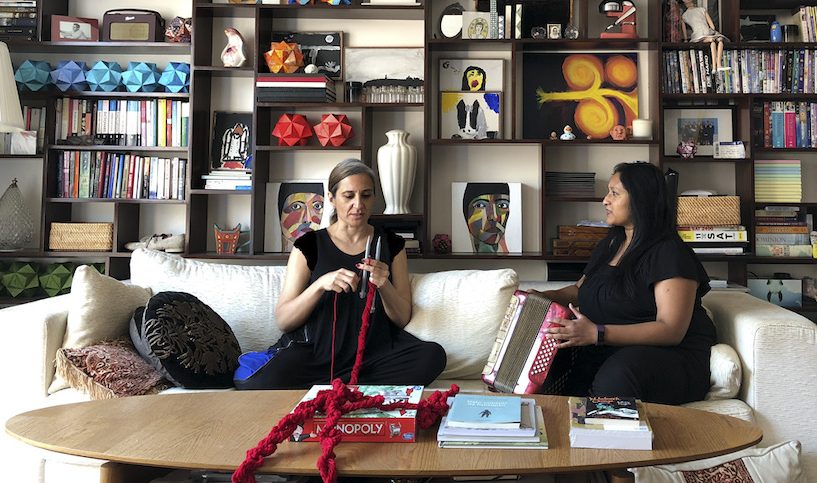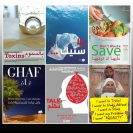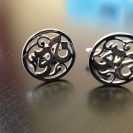By Ayesha Kamal
I walk into Ghadah Alkandari’s house and I am immediately envel- oped in warmth; from the welcoming hug to the hot cup of tea in my hands to the colorful surroundings. At first, I wonder if my writing about her art and upcoming show will be a different conversation from those we normally have during our weekly Thurs- day meetups. We usually talk about what is going on in our world, analyze our evolving emotions, and strategize on how to tackle difficult situations. We mull over complex issues, such as managing close relationships, and simpler ones like decid- ing the color of our hair. What I come to realize is that those topics are not irrelevant to her art at all. In fact, they are deeply connected and represented in her work, as it is driven by events in her life.
This particular show Hurricane PM: My Life From October to October, being exhibited at Dar al Funoon from October 22 to November 1, is an autobiographical retelling of the past year of her life. It relays the story of an incident that sparked a cascade of events that made an impact on Ghadah physically, emotionally, and spiritually, and as such, are represented throughout her work. Starting from a time of darkness, stormy moods, and turmoil, she progressed to a point where she finally saw a clearing in the path: a clean state, a new phase, a hopeful future.
It is interesting to walk into a familiar space with a new pair of spectacles on. I am not just sitting in my friend Ghadah’s house but rather with an artist in her studio. But are they not one and the same? Over the next couple of hours, we talk and laugh as usual, and within that time, I learn more about her creative process and the events that trigger her creative flow.
View this post on Instagram
Welcome to the -er months, my favorite time of year. Happy September everyone x
Ghadah’s Creative Process
One of the things that I love most about Ghadah’s house is that it is constantly changing: a table in the hallway, an easel by the window or perhaps against a wall, canvases up, canvases down, along with an assortment of paints and brushes. Her house is like an art installation in itself. She tells me that her surroundings are very much representative of her creative process, which itself is a cycle of change, starting from ordered surroundings and a blank canvas to chaos and color. She tells me,
“You can look at my process as a cycle: there is a neat room, ordered. Then when I start, there’s no way I am going to put things back in order while I’m painting. It’s like when you get a new set of color pencils. You really want to put everything back in rainbow order. But there’s no way, that after using it for a year it’s going to go back to how it was. The work continues, and then when I’m done, I clean up. Everything falls back in order.”
At the moment, Ghadah is working on decluttering her house. Furniture that has been there for years is being taken away. The walls are being painted. A new space is being created. Just as her body, emotions, and mindset have been going through a transition over the past year, so has her house. At the moment, it is having an impact on her creativity. She says,
“I just need to get my house sorted out. It’s important that I do that before I move on because I can’t paint with a clutter. It’s all such a big part of my life, that’s why it’s so important. My life is essential to the paintings and the paintings are essential to my life.”
What strikes me most about our conversation is the normality of it all. We are sitting on the sofa chatting as usual, and everything seems as it always was. However, as it becomes evident in the way Ghadah discusses her creative process, when you are in a particular mindset, certain events seem anything but normal. We have this incredible ability (handicap?) to filter what we see, hear, think, and understand based on where our mind is at in that very moment. This selectiveness is guided by our emotions, whether we realize it or not.
Ghadah shares a story:
“I had a jar with some of my paintbrushes in it. I had washed it, filled it back up with water, and placed it back on the table to continue painting. I couldn’t for the life of me find it again. I knew it was on that cluttered table. And I needed those paintbrushes. So I got a new jar and found another set of brushes similar to the ones in the lost jar. I put the new jar down and start painting. When I was done, I placed my paintbrush back into the original jar, which was there all along. Just where it was supposed to be. To me that exemplified how my brain is when I’m working. Colors: I’ll go to pick up yellow and end up picking up red. It’s just crazy.”
Even though the jar had always been there, she could not see it. There was something in her that did not allow her to see what was obviously there, but then her instinctive mind and automatic reflex guided her back to where she needed to be. While she does create her art with a certain framework in mind, sometimes what she produces is driven by happenstance.
“I’m still learning so much. When I’m painting, I’m discovering techniques. It’s fun, it’s trial and error. When I have a show coming up, I purposefully don’t look at any other art. I just want it all to come from me. I’m not inventing anything, but I’m inventing it to myself. And so much of it is circumstantial. Let’s say I use a brush and this brush is coarse or has some old bits of paint on it, it can have a really interesting effect.”
Painting her Experience
October 1, 2017 marked the start of a change for Ghadah. That night she experienced the first of a series of anxiety attacks while on an extended visit to London. While biologically the experience may have been understood and even in some ways expected, it was still hard to completely grasp the changes that were happening inside her. Anxiety, triggered by what? A blocked ear, triggered by what? She was surrounded by unanswered questions and looking at a path in front of her, destination unknown. The painting process has been the venture down that path.
While this collection of works may have started because of a struggle that was quite emotional and difficult to get through, it has turned into a voyage of discovery. Her paintings are truly organic in nature as there is no way she can predict her thoughts and emotions or how they will develop as they are anchored in her life circumstances.
Ghadah describes her first painting as one that is stormy and dark, which depicts the emotional space she was in, and it comes out in her painting. When I ask her about it she tells me that it is not finished, but it is complete. She explains,
“The first painting I did for the show is very dark. Literally dark. Dark colors. It’s not finished but it’s done, because I feel it’s complete. But I also can’t finish it because I am not where I was when I started it. Where I was when I began was a transitional state between being debilitatingly depressed and anxious to one where I was slightly so and could do something about it. It helped to create the painting. It was just something I needed to do. It’s scary when you’re debilitated to the point where you can’t feel joy in your work.”
Upon realizing that something was wrong, she sought treatment in acupuncture, with the hope of removing this mysterious blockage that has affected her ears. This process was therapeutic and revealing and was the theme of another two of her paintings, one of which is her current favorites. She describes the woman in it:
“There’s something about her face. Again, I always think that I didn’t create the face, it just happened. When you’re painting an imaginary person, they become a human being detached from yourself. She’s like a stranger; she’s there and she’s looking at you. As I painted her left eye, my hand shook and it created this line that looked like a tear. So I left it the way it was, almost like a tattoo. I didn’t mean for her to cry, but she did. It’s exciting. I look at all these empty canvases and I wonder what’s going to happen. Every one of them is like a little trip somewhere, a little experience.”
https://www.instagram.com/p/BoMLC7Dh-5n/?taken-by=prettygreenbullet
The Symbolism of Red
The color red is particularly significant in Ghadah’s current work. Aside from being a striking, vibrant color, it is also one that symbolizes a life force. It is the color of our blood. It represents vitality and passion, as well as danger. For Ghadah, it particularly represents a change within herself: physically, chemically, emotionally. Her life force was shaken so violently that it took her to an unfamiliar territory. This physical change that she has been going through is accompanied by unexpected emotions, uncontrollable physical symptoms, and unpredictable outcomes.
We discuss the symbolism of red. To me, I associate it with lava simmering and bubbling inside a volcano, representing my own inner turmoil. The eruption of the volcano symbolizes a relief, with the red, fiery lava covering all the surrounding surfaces. She agrees:
“It is like that. It is a volcano. You are festering. All this stuff is inside you. For me, now, looking back at October 1st, when it all began, sometimes I think I just had a nervous breakdown. And being alone didn’t help. I still try to figure it out. Parts of me think it was almost mystical. It just didn’t make any sense. Ultimately, it was a nonromantic explanation that I settled on: menopause. There was no way to romanticize it, this is as romantic as it gets.”
https://www.instagram.com/p/Bn-7asAhOAz/?taken-by=prettygreenbullet
Womanity
It was through these physical changes that the feeling of womanhood was emphasized. While gender can never be isolated from who we are, this current cycle of change served as a reminder of constant evolution, continued turmoil. A ticking clock. While mulling over these changes, she came up with a word: Womanity. She explains:
“It was the first time I wished I wasn’t a woman.As women we are constantly going through change: you go through puberty, that’s turmoil. Pregnancy, birth, post-partum depression. And you would think that by now I’d have experienced it all. But no, surprise! It’s this. We are constantly fluctuating, always on our toes. It has affected a couple relationships with me. Not that it should have, but it has. It’s just been a year of introspection for me as a woman. And a re-examination of my past. Remembering that I did have anxiety in the past, like when I was pregnant. There was a feeling of deep depression. That feeling of no joy and detachment was scary. But at the time sleeping helped. Last October, I couldn’t even do that.”
Searching for a Resting Place
Ghadah is not unfamiliar with struggle and emotional detachment. She has experienced it before. However, in the past, she was able to find an escape in sleep. This time it was different. Rather than being able to escape to her bed for safety and comfort to rest, recover, and maybe even dream, ‘bed’ became an unfriendly place. One sleepless night became a second and it continued to spiral out of control. It seemed that the only way to get back to sleep was to make the bed more comfortable, more alluring, adorned with the temptation of sleep. But time has showed that the layers of clutter did not provide comfort. They were a distraction. They were occupying a space within her that needed to be free. What was needed was a complete cleansing, a clean slate without any obstruction from miscellaneous people or things. Sometimes it is only when we are stripped bare that the truth is allowed to emerge. She explains her painting Bed.
“The concept of a bed was important because I went through months when I couldn’t sleep in a bed. Any bed. And I would only sleep on the couch. In the painting I’m being carried by a man taking me to that bed (or away from it, I’m not sure) and just looking over me. My bed wasn’t a friendly place, and I needed a friendly place to sleep. When that bed isn’t friendly and feels like a beast, it feels like you’re dying. It’s not something you want in your room. So I have a new bed now.”
https://www.instagram.com/p/BoRSxlFBYfA/?taken-by=prettygreenbullet
Knitting it all Together
One of the three components in her upcoming exhibition will be a knit installation that she has been working on for the past year.
“The knitting is important because it’s a tactile way to represent this blood that disrupted my life a few years ago, and I ultimately had to undergo a D&C. It disrupted my days. It disrupted my trips. I couldn’t go out, it was like a flood. Life became unpredictable. You don’t know when it’s going to come and it’s all that uncertainty and fear. So it felt right to create this red cascade of sinewy blood. I wanted to make something visceral, literally and figuratively, and hopefully when I put it together, it will be stunning.”
https://www.instagram.com/p/Boa3305hPmn/?taken-by=prettygreenbullet
Connecting through Art
Ghadah’s hope is to serve as an ambassador for Kuwait through her artwork. It is through her
brushstrokes that she sees herself as a patriot and representative of her country. I ask her what she hopes others will get from the show, she says,
“I want them to feel something. I don’t want them to glance and then look away. I want people to stare, even if it’s just staring at one little spot because they love the way the color is peeping through. It’s always good when it moves people to tears. Or makes them laugh or smile. It is what it served me and then it’s whatever it serves everybody else.”
This exhibition offers a glimpse into the deciphering process that Ghadah has gone through in the past year. It takes you along on a journey from pain and darkness to one of healing and light. The act of painting captures the image in her mind’s eye and unearths the connection between emotional connections and physical manifestations.
“I think if you look back in retrospect you can always tell the story of my life through these works by putting my paintings side by side. And this is just one little chapter of that story.”
https://www.instagram.com/p/BnstDKDhFxr/?taken-by=prettygreenbullet
For more information about Ghadah Alkandari’s upcoming exhibition check our events page and please follow @prettygreenbullet on Instagram.
Featured image courtesy of Ayesha Kamal.








